Peace Park, Hiroshima
last update: September 30, 2022
The Hiroshima Peace Memorial Park (平和記念公園, Heiwa Kinen Kōen) is one of the most important places in the city, covering an area of over 120,000 square meters and being visited by more than a million of people per year. Before the bomb, the area of the current park was the commercial heart of the city, and for this reason it was chosen as the target. After the bomb, it became an open field created by the explosion. Four years after that day, it was decided that the area would not be rebuilt but instead would remain dedicated to the memory of what happened, to commemorate the 140,000 victims who lost their lives that day and in the following, but also to perpetuate the memory of nuclear horrors and sustain world peace. Hiroshima was in fact the first city in the world to suffer a nuclear attack, on August 5, 1945.
Things to do and things to see at the Peace Park
Today the Peace Park is a vast area characterized by trees and green lawns, along the banks of the Motoyasu River, which houses numerous memorials, monuments and museums. There are nearly 50 memorials in and around the park built over the years. Stroll through the paths of the park to discover its monuments, and take advantage of these moments to reflect on the meaning of life, of war, and on the luck you had to be born in an era where nuclear weapons are, at least for the moment, not a threat to your safety. Looking back on the tragedy of Hiroshima and the Second World War, all your little personal problems of contemporary society will seem like trifles.
The main structure of the park is the
Peace Memorial Museum, a large museum designed by the famous Japanese architect
Kenzō Tange. Continuing along the central avenue of the park, you will find the
Commemorative Cenotaph, dating back to 1952, with the
pond of peace and the
flame of peace, which has been burning continuously since it was ignited in 1964 and which is proposed to remain alight until all nuclear bombs on the planet are destroyed. On the right of the pond of peace is the
Peace Memorial Hall, a small but touching museum with free admission among the most recent buildings inaugurated in the park. A little further on you will find the famous
Children's Peace Monument and the
Rest House, a building that survived the explosion that currently houses a tourist information center. Finally, on the other side of the river, there is perhaps the main symbol of Hiroshima, namely the
A-Bomb Dome, a skeleton of a building that barely stands upright, left as it was reduced after the explosion in memory of the tragic event.
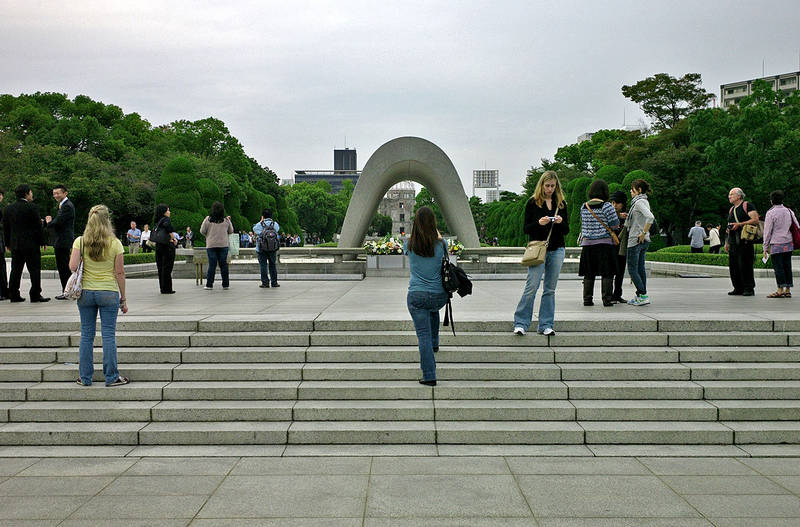
Peace Memorial Museum
(admission 200¥, opening hours 8:30-18, until 5pm dec-feb, until 19 in august)
This museum, inaugurated in 1955 and designed by Kenzo Tange, is the main building of the park, and is visited by around one million people every year. In 1994 a second building (east wing) was added to the main central building. Today each of these buildings has a different exhibition function. The central building (called the west wing) is dedicated to the damage caused by the atomic explosion and subsequent radiation, on humans and objects, with many personal details on the victims. It is the most touching section of the museum, one of the purposes of the existence of this museum is in fact to convey the horrors of the event to posterity. The east wing is mainly dedicated to the history of the city of Hiroshima before the bomb and after, but there is also a section dedicated to nuclear weapons, and a series of videos of the survivors of the event. The museum has been visited over the decades by several heads of state and prominent figures from different countries. It is a unique place in the world, to be visited with the right mindset.
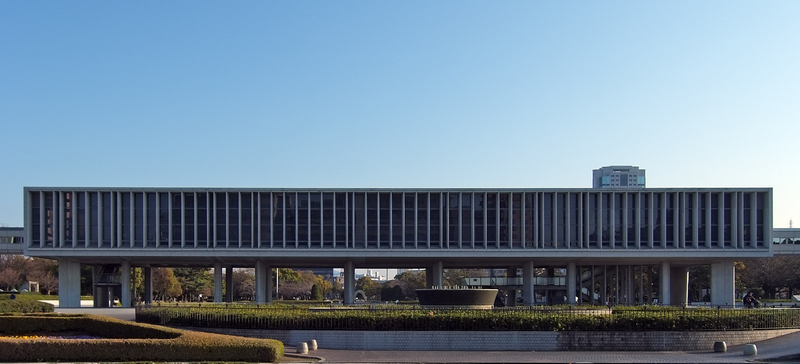 the main building of the Peace Memorial Museum
the main building of the Peace Memorial Museum
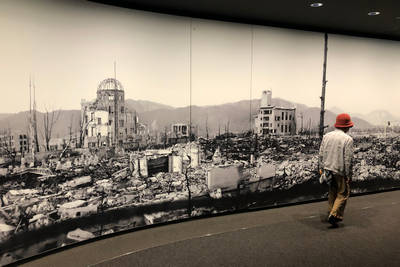
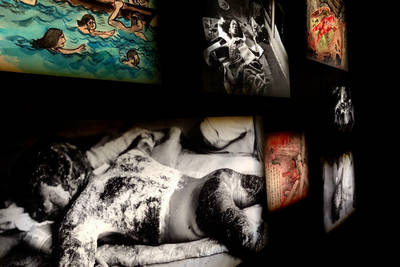 some touching images of the inside of the museum
some touching images of the inside of the museum
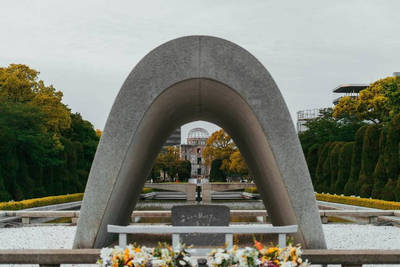
Commemorative cenotaph
The Cenotaph is a concrete arched tomb for those who died from the bomb, both in the initial explosion and later due to the radiation. Under the arch, which symbolizes a shelter for the souls passed away, there is a stone chest that contains all the more than 220,000 names of the recognized victims. This cenotaph was one of the first memorials built in Hiroshima, in 1952. The cenotaph carries an epitaph which can be translated as "let all souls here rest in peace, for we will not repeat the mistake". The position of this cenotaph ensures that the arch is perfectly aligned with both the flame of peace and the A-Bomb Dome, perfectly visible under the arch.
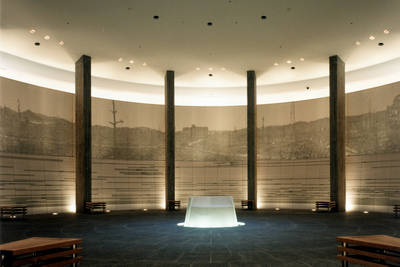
Peace Memorial Hall
(free admission)
The Peace Memorial Hall is a place dedicated to collecting the names and photographs of the people who died in the explosion. It was inaugurated in 2002 by the national government, with the aim of commemorating the victims by collecting memories and stories of the survivors before it was too late. Like the Cenotaph and the Peace Memorial Museum, it was designed by architect Kenzo Tange. On the roof, near the entrance (the museum is underground) there is a clock stopped at 8:15, the time the bomb exploded. The museum entrance leads down to a hall for contemplation, and then back to a series of touching stories and memories of the survivors (in English and Japanese).
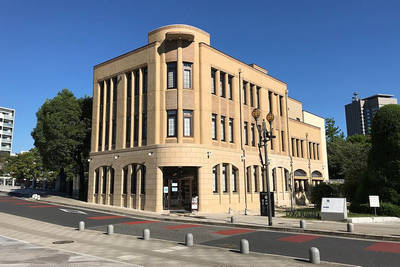
Rest House
The Peace Park Rest House in Hiroshima is another building that survived the bombing. The building was built in 1929 to house a kimono shop, which closed in 1943. At the time of the bombing, it was used as a fuel distribution station. 37 people worked there and all perished, with the exception of Eizo Nomura, who at that moment had gone down to the basement and managed to miraculously survive. Although the building was badly damaged, it was remodeled soon after the war. In recent decades, the local government has often debated whether or not to preserve it. Currently, the first floor is used as a tourist information center with a souvenir shop, the upper floors house offices and the basement is preserved almost as it was at the time of the bombing.
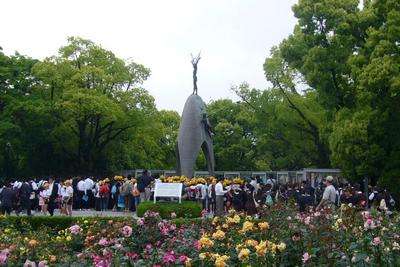
Children's Peace Monument
This monument, one of the most visited and touching in the park, is dedicated to all the children who died from the atomic bomb. On top of the monument is a statue of a little girl holding a crane. That child depicted is Sadako Sasaki, a survivor of the explosion who later fell ill with leukemia, and who moved the nation because during her last period of life in the hospital she never stopped folding origami depicting cranes, according to an ancient Japanese legend according to which whoever made a thousand paper cranes could have made a wish. In 1955 the girl died. Near this monument there are now hundreds of origami that are continually brought by visitors, and in particular by schoolchildren visiting the park.
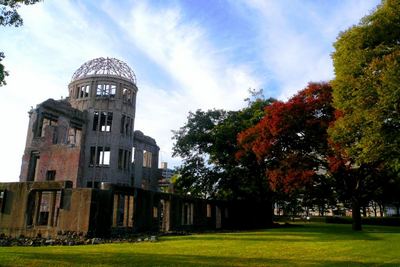
A-Bomb Dome
The A-Bomb Dome, also officially known as the Hiroshima Peace Memorial, is the closest building to the hypocenter that didn't completely collapse after the atomic bomb went off. The authorities of the time decided to leave it intact in the condition in which it was found, that is, little more than a skeleton of a building, as a testimony of the terrible event. It had been built in 1915, and housed the headquarters of the industrial promotion body of the city. In 1996 it became part of the UNESCO World Heritage Site.
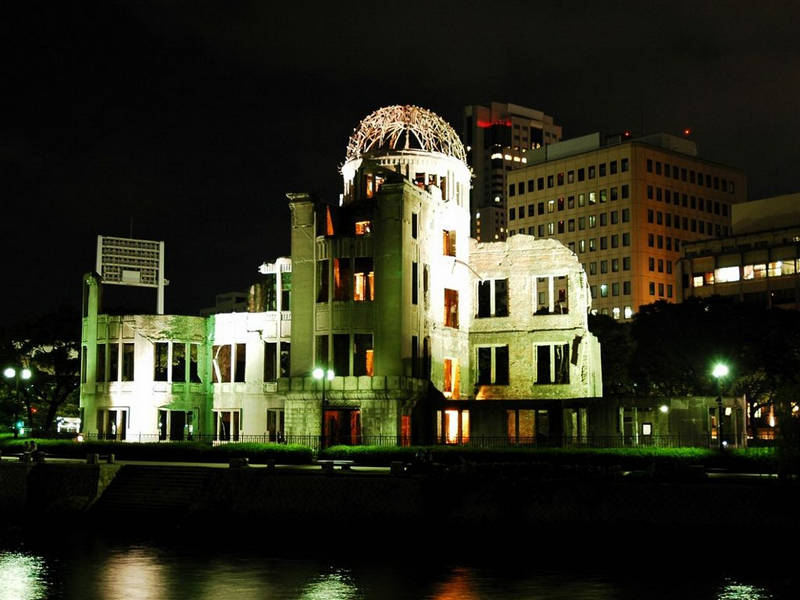 the lit A-bomb Dome
the lit A-bomb Dome
How to get to the Peace Park
The Peace Park is located in the center of Hiroshima city, but the city's main station (JR Hiroshima) is two and a half kilometers away. If taking a long half hour walk isn't your thing, the nearest tram stop is
Genbaku-Domu Mae (原爆ドーム前), served by line 2 and line 6. From Hiroshima station the journey takes about 15 minutes (190¥). Alternatively, all three lines of the Hiroshima Sightseeing Loop Bus (Meipuru-pu) stop near the park.
Map of the Peace Park, Hiroshima
Guided tours, activities and other things to do
If you are planning a trip to Japan and you want to do something more than just visiting famous places and monuments, we suggest you to use
Rakuten Travel Experiences.
How to use Rakuten Travel Experiences
Rakuten Travel is a very useful website to
enrich your travel experience, especially if you are going solo or it's your first time in Japan.
Because of the language barrier (and more), in Japan it is very difficult to interact with the locals and to get off the tourist track.
Thanks to Rakuten Travel you can find a lot of interesting and sometimes unique
guided tours and activities all over Japan (and not only in Japan), that you would otherwise never be able to enjoy.
But there's more: on Rakuten Travel you can also
buy tickets for several famous attractions, events, transportation and other useful services for tourists. Last but not least, you can
reserve a table in hundreds of restaurants.
Some examples
Take a look at Rakuten Travel Experiences
You may also be interested in




